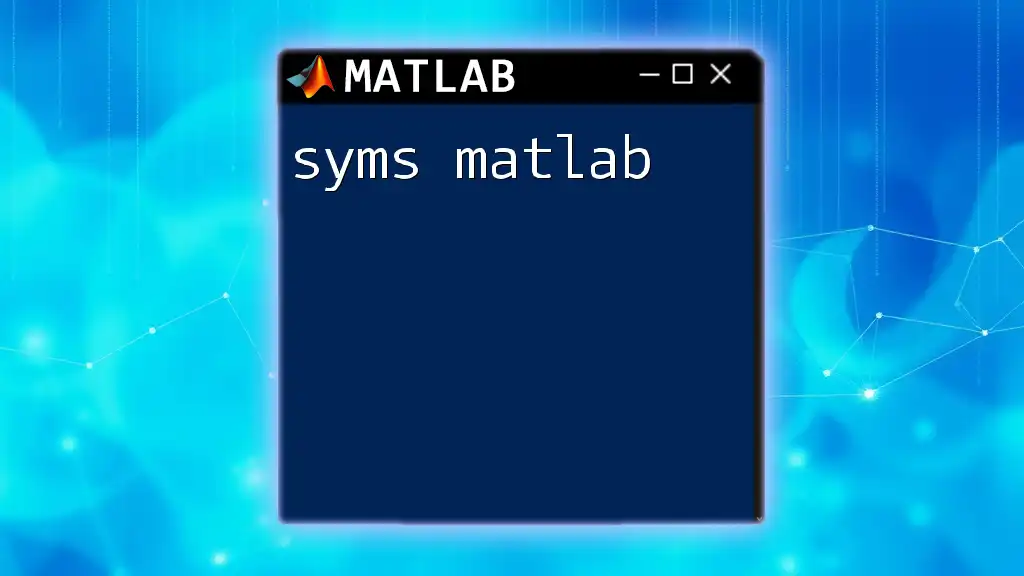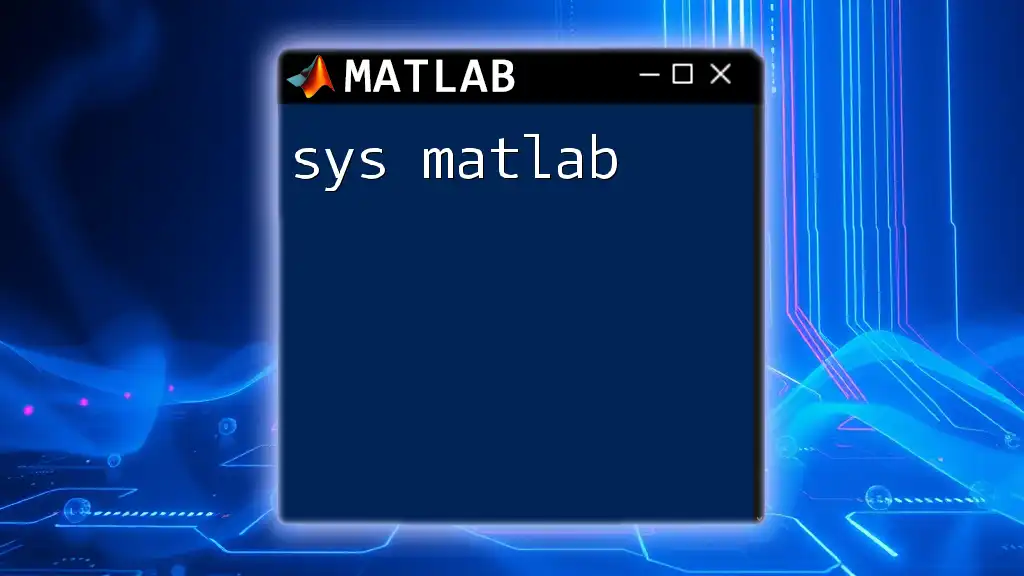In MATLAB, the `syms` command is used to create symbolic variables for mathematical calculations and expressions.
syms x y
f = x^2 + y^2;
What is `syms` in MATLAB?
Definition of Symbolic Variables
In MATLAB, `syms` is used to define symbolic variables. Symbolic variables allow users to perform algebraic calculations analytically rather than numerically. Unlike numeric variables that represent fixed values, symbolic variables represent mathematical symbols and can stand for any number.
Symbolic computation is particularly useful in fields like engineering and mathematics where equations are manipulated without immediately substituting numerical values. For example, defining an equation parametrically lets the user analyze various conditions before solving it analytically.
When to Use `syms`
Use `syms` when:
- You need to perform symbolic mathematics, such as algebraic manipulation or calculus operations.
- Exact solutions are preferred over approximate numerical results.
- Analyzing the behavior of mathematical models under varying conditions is needed.
The advantages of symbolic computation include:
- More straightforward manipulation of algebraic expressions.
- Capability to obtain exact solutions for polynomials, rational functions, and differential equations.

Getting Started with `syms`
Creating Symbolic Variables
To create a symbolic variable, use the following syntax:
syms x
This command defines `x` as a symbolic variable, allowing it to represent mathematical expressions.
Defining Multiple Variables
You can define multiple symbolic variables in one command by separating them with commas:
syms x y z
This line creates three symbolic variables: `x`, `y`, and `z`, each of which can be used in mathematical expressions independently.
Specifying Variable Types
In some cases, you might want to specify particular types for your symbolic variables. You can achieve this by using the `sym` function. For example:
a = sym('a', 'real');
This command creates a real symbolic variable `a`, ensuring that any operations performed with `a` will consider its properties as a real number.

Using Symbolic Variables in Expressions
Basic Operations
You can perform various operations on symbolic variables just like regular numbers. For instance, to define a quadratic function:
f = x^2 + 3*x + 5;
MATLAB evaluates this expression symbolically, meaning you can manipulate it algebraically or compute its derivative.
More Complex Expressions
Creating polynomials or rational functions can also be performed seamlessly. Here's how to create a cubic polynomial:
p = x^3 - 4*x^2 + 7*x - 2;
Since `p` is a symbolic expression, you can further manipulate it—like factoring or expanding.
Using Functions with Symbolic Variables
MATLAB allows you to define symbolic functions easily. For example, you can combine trigonometric functions as follows:
f = sin(x) + cos(x);
This expression will be treated as a symbolic function, enabling you to conduct further operations like differentiation or integration.

Solving Equations with Symbolic Variables
Solving Algebraic Equations
Symbolic variables excel in solving algebraic equations. Utilize the `solve` function for this:
solution = solve(f==0, x);
This command will return the solutions of the equation represented by `f`, allowing you to work with exact roots rather than numerical approximations.
Solving Differential Equations
Symbolic computation can also help solve differential equations. Consider this example where you solve a first-order ordinary differential equation:
syms y(t)
Dy = diff(y, t);
diff_eq = Dy == y;
sol = dsolve(diff_eq);
Here, `dsolve` provides a symbolic solution to the differential equation defined by `diff_eq`.
Finding Limits and Integrals
Another powerful feature of symbolic variables is the ability to calculate limits and integrals. For instance, finding the limit of an expression as `x` approaches 0:
limit_value = limit(f, x, 0);
This command provides the exact limit value instead of a numeric approximation.
To compute an integral, you can use:
integral_value = int(f, x, 0, 1);
This evaluates the definite integral of the function `f` between the limits 0 and 1, returning an exact result.

Plotting Symbolic Expressions
Using `fplot` for Visual Representation
Visualizing data is as vital in symbolic computation as in numerical analysis. You can utilize `fplot` to graph symbolic functions. Here's an example:
fplot(f, [-10, 10]);
This command plots the symbolic function `f` over the range from -10 to 10.
Customizing Plots
MATLAB allows customization of plots. Adding titles and labels can enhance clarity. For example:
fplot(f); title('Plot of f'); xlabel('x'); ylabel('f(x)'); grid on;
This command provides labeled axes and a title for the plot, making it more informative.

Best Practices and Tips
Efficiency in Symbolic Computation
To enhance the efficiency of symbolic computations, it is essential to simplify expressions. Utilize built-in functions like `simplify`, `expand`, and `factor`. For instance, to simplify an expression:
simplified_expr = simplify(f);
This command reduces `f` to its simplest form while retaining its value.
Common Pitfalls
When using `syms`, one common error users face is forgetting to declare variables as symbolic before using them in equations. This oversight can lead to unexpected results or errors. Always check that you've properly engaged symbolic variables, and consult the MATLAB documentation for troubleshooting tips.

Conclusion
The `syms` command in MATLAB opens up a realm of possibilities in symbolic computation. By leveraging its features, users can perform sophisticated mathematical operations, solve complex equations, and visualize results clearly. Taking advantage of symbolic capabilities enhances precision and provides a robust toolset for tackling challenging mathematical problems. Exploring further functionalities and combining these techniques will significantly elevate your MATLAB experience.

Further Resources
For additional learning, consider checking the official MATLAB documentation, which provides more in-depth examples and tutorials on symbolic computation. Online courses and MATLAB-related learning platforms can also offer more structured learning pathways.

















